Inherited pancreatic endocrine tumor syndromes: advances in molecular pathogenesis, diagnosis, management, and controversies
- PMID: 18798544
- PMCID: PMC2574000
- DOI: 10.1002/cncr.23648
Inherited pancreatic endocrine tumor syndromes: advances in molecular pathogenesis, diagnosis, management, and controversies
Abstract
Pancreatic endocrine tumors (PETs) can occur as part of 4 inherited disorders, including Multiple Endocrine Neoplasia type 1 (MEN1), von Hippel-Lindau disease (VHL), neurofibromatosis 1 (NF-1) (von Recklinghausen disease), and the tuberous sclerosis complex (TSC). The relative frequency with which patients who have these disorders develop PETs is MEN1>VHL>NF-1>TSC. Over the last few years, there have been major advances in the understanding of the genetics and molecular pathogenesis of these disorders as well in the localization and the medical and surgical treatment of PETs in such patients. The study of PETs in these disorders not only has provided insights into the possible pathogenesis of sporadic PETs but also has presented several unique management and treatment issues, some of which are applicable to patients with sporadic PETs. Therefore, the study of PETs in these uncommon disorders has provided valuable insights that, in many cases, are applicable to the general group of patients with sporadic PETs. In this article, these areas are reviewed briefly along with the current state of knowledge of the PETs in these disorders, and the controversies that exist in their management are summarized briefly and discussed.
Figures






References
-
- Oberg K, Eriksson B. Endocrine tumours of the pancreas. Best Pract Res Clin Gastroenterol. 2005;19:753–81. - PubMed
-
- Mignon M, Jensen RT, editors. Endocrine Tumors of the Pancreas: Recent Advances in Research and Management. Vol. 23. Basel, Switzerland: S. Karger; 1995.
-
- Jensen RT, Norton JA. Endocrine tumors of the panceas and gastrointestinal tract. In: Feldman M, Friedman LS, Brandt LJ, editors. Sleisinger and Fordtrans’s Gastrointestinal and Liver Disease. 8. Philadelphia: Saunders; 2006. pp. 625–66.
-
- Falconi M, Plockinger U, Kwekkeboom DJ, et al. Well-differentiated pancreatic nonfunctioning tumors/carcinoma. Neuroendocrinology. 2006;84:196–211. - PubMed
-
- Jensen RT, Niederle B, Mitry E, et al. Gastrinoma (duodenal and pancreatic) Neuroendocrinology. 2006;84:173–82. - PubMed
Publication types
MeSH terms
Grants and funding
LinkOut - more resources
Full Text Sources
Medical
Research Materials
Miscellaneous

